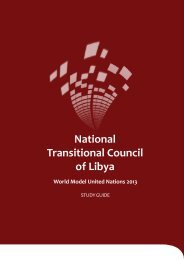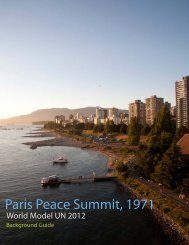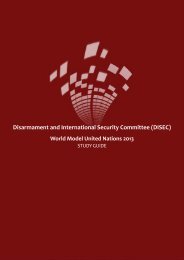Social, Humanitarian and Cultural Committee (SOCHUM)
Social, Humanitarian and Cultural Committee (SOCHUM)
Social, Humanitarian and Cultural Committee (SOCHUM)
You also want an ePaper? Increase the reach of your titles
YUMPU automatically turns print PDFs into web optimized ePapers that Google loves.
improvement are available exclusively in dominant<br />
languages. 40 today, the most dominant language<br />
across the world is English, but Spanish, French,<br />
<strong>and</strong> Portuguese are also languages that have<br />
provided employment for indigenous populations.<br />
in the process of learning a dominant language as<br />
a method of socioeconomic improvement, many<br />
minorities stop speaking their indigenous language<br />
either through disuse or active ab<strong>and</strong>onment, a<br />
phenomenon called social dislocation. 41 Often,<br />
the economic effects of globalization on minority<br />
languages are tied closely to other causes of language<br />
endangerment. Because most African countries offer<br />
no education in indigenous languages, for example,<br />
minority populations must start using the dominant<br />
language if they wish to attend secondary school or<br />
university <strong>and</strong> hold a well-paying job. The dislocation<br />
of a population because of a natural disaster can also<br />
lead to the ab<strong>and</strong>onment of indigenous languages<br />
<strong>and</strong> their subsequent endangerment, as the<br />
speakers often must utilize a different language to<br />
find employment in their new home. 42 Additionally,<br />
globalization can also lead to language endangerment<br />
through exposure to advertising, newspapers, <strong>and</strong><br />
television in the dominant language of the state.<br />
Many indigenous languages lack their own media, so<br />
speakers of these languages are consistently exposed<br />
to information in the dominant language via radio,<br />
television, <strong>and</strong> newspapers, which can contribute to<br />
the disuse of the mother tongue <strong>and</strong> the adoption of<br />
the dominant language. 43<br />
As is obvious in their descriptions, the causes of<br />
language endangerment are by no means mutually<br />
exclusive; in fact, they almost always interact to reduce<br />
the number of speakers of an indigenous language<br />
<strong>and</strong> eventually eliminate the language altogether.<br />
An official policy against an indigenous language, for<br />
example, may reduce the economic opportunities<br />
available in that language, which encourages speakers<br />
to ab<strong>and</strong>on their mother tongue for the dominant<br />
language. Alternatively, the idea that bilingualism is<br />
unhealthy may lead to negative self-perception by<br />
speakers of both a dominant <strong>and</strong> a minority language<br />
<strong>and</strong> cause them to pass only the dominant language<br />
onto their children. Thus, when evaluating an instance<br />
of language endangerment, it is vital to examine all<br />
of the factors, political, economic, <strong>and</strong> psychological,<br />
that have led to the decay of a specific language.<br />
Current Situation<br />
Given the numerous causes for language<br />
endangerment outlined above, it is not surprising<br />
that more languages are nearing extinction than ever<br />
before. There are a number of ways to quantify the<br />
issue of language endangerment, <strong>and</strong> each method<br />
reveals an additional aspect of the problem.<br />
The first way to quantify language endangerment<br />
is by examining the number of speakers of both the<br />
dominant languages that are driving indigenous<br />
languages toward extinction <strong>and</strong> the indigenous<br />
languages themselves. Fortunately, the Summer<br />
Institute of Linguistics (SIL) has been publishing a<br />
book of statistics on language since 1951 entitled<br />
Ethnologue: Languages of the World. According<br />
to an analysis of the Ethnologue by David Crystal<br />
about ten years ago, eight languages (M<strong>and</strong>arin<br />
Chinese, Spanish, English, Bengali, Hindi, Portuguese,<br />
Russian, <strong>and</strong> Japanese) each have over 100 million<br />
speakers <strong>and</strong> together have nearly 2.4 billion. With<br />
the next twelve on the Ethnologue’s list, the top<br />
twenty languages encompass half of the world’s<br />
population. 44 As Crystal’s analysis was completed<br />
with data from 1999, these figures are even higher<br />
today. the Ethnologue’s 2009 edition reveals that<br />
over 94% of the world’s population speaks 5.6% of the<br />
world’s languages, those with more than one million<br />
speakers. 45 These figures show just how widespread<br />
the international dominant languages have become.<br />
Conversely, the distribution of indigenous<br />
17<br />
Melbourne Host Directorate PTY LTD | Office of Media <strong>and</strong> Design

















